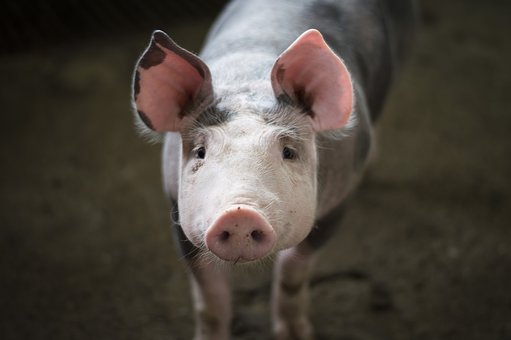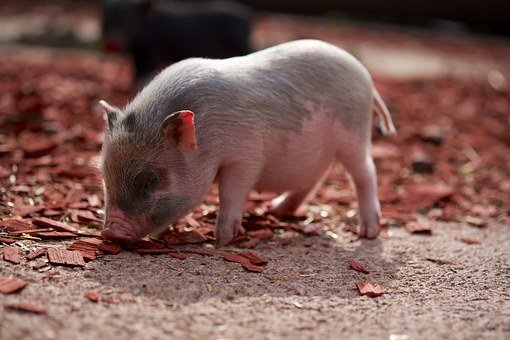Pet Pigs
Cute movies about animals and irresponsible pet owners can sometimes lead to real animals living very short lives. When 101 DALMATIANS came out, there was a rush to breeders for cute Dalmatian puppies. But when the pups grew to be big dogs who were no longer cute, some found themselves dumped at the nearest animal shelter. Similarly, when the movie BABE was released, some children begged for a pet pig and potbellied piglets were in high demand. Only piglets grow up too--often to as much as 150 pounds (more if fed incorrectly)--and some of these unfortunate critters also ended up in shelters and sanctuaries.
BABE and its sequel BABE: PIG IN THE CITY have encouraged children's interest in potbellied pigs. But the North American Potbellied Pig Association (NAPPA) is warning families against rushing out to purchase a pig. Owning a potbellied, it says, can be the beginning of a wonderful love affair; or the beginning of an overwhelming responsibility, if you are not prepared.
To find out if a pig is a good pet for your family, experts suggest getting in touch with groups like the NAPPA or the New Jersey Potbellied Pig Association (NJPPA). Find out about the pig's temperament, size, training methods, daily care, and health care and make sure potbellied pigs are allowed under the pet ordinance in your town.
Laura, a Passaic County resident in New Jersey, found out the hard way that not everybody appreciates having a pig as a neighbor.
The problem is pigs are very misunderstood--people think they are dirty when in fact they are very clean animalssays Laura, who shares her home with her four-year-old potbellied pig Roy.
Taking care of them is not a problem--in fact that's easy. It's neighbors who don't understand that pigs are not a problem.As a result of the neighbor problem, Laura has had to spend thousands in lawyers fees and has moved four times, finally settling on four acres in a town that allows for potbellied pigs as pets.
As you research the pig, you need to be honest with yourself, according to the NAPPA. Some of the important questions to ask are: Can you afford to purchase a pig? A neutered or spayed registered piglet can cost between $400 to $600 but prices vary depending on location, and then there's the cost of care to take into account. Does your community have restrictions on owning a pig? Are you away a lot? Who will watch the pig when you are away? Will the pig have private space in your home and in the yard? Is your yard fenced in order to keep your pig safe and prevent him or her from wandering onto a neighbor's property? Do you have the necessary time to properly train your pig?
If, after considering these questions, a family still feels it can provide a good home for a pig, it's time to look for a reputable breeder, experts say. They warn against going to breeders who do not come recommended by recognized groups, such as the NAPPA. There are horror stories, they say, of families buying what they think is a potbellied pig only to find their pet is not that breed at all, and grows to a whopping 300 and 400 pounds, totally unsuitable as a house pet.
Potbellied pigs are compact, carrying the bulk of their weight between--between 40 and 150 pounds--in their bellies. They live between 10 and 15 years.
According to NAPPA, families in the market for a pig should screen breeders carefully. That means visiting his home so you can see the parents of the piglet you are thinking about purchasing. Notice how the pigs and breeder interact--do the pigs act friendly to her or do they shy away? Good breeders will also be screening the prospective family because they want to make sure they are giving their piglets to good homes. And good breeders will also make themselves available to answer questions, once the piglet is settled in its new home, the experts say. Another option is to adopt a potbellied pig, and NAPPA can provide information on that.
Once the correct procedures have been followed and the piglet is home, the family is in for hours of fun, say those who share their lives with pigs. Potbellied pigs get along well with children and other pets. They are clean and easy to train, make good watch pigs, and are usually not very loud. The potbellied pig is thought to be one of the best pets for people with disabilities as they are easily trained, housebroken, have reasoning abilities, and can learn tricks and problem-solving quickly.
A mature potbellied pig is said to have the same amount of intelligence as a three- or four-year-old child,says Alice Randall-Riley, a New Jersey resident who owns two potbellied pigs and has written extensively on the behavior, care, and antics of the pigs.
A friend of mine has trained her pig with flash cards. She puts alphabet cards on the floor and asks her pig to spell out her name. The pig knows enough to go through the whole pile and spell out "Nelly."This high level of intelligence leads quickly to boredom if pigs are forced to spend too many hours alone, experts say. If the family won't interact with its pig, the pig will find other ways to have fun. For instance, families have come home to find the laundry scattered over the floor or pots and pans pulled from cabinets. Others have found holes in doors and rugs as a result of the pig's natural rooting instincts. These instincts can be redirected in creative ways, experts say. One way is to roll up a carpet and let the pig roll it out with its nose, an action that comes naturally to pigs. Some pigs love to spend hours hitting a ball against a wall with their noses.
To avoid problems like food and magazine-rack raids, families will need to pig-proof their homes, say longtime pig owners. This includes putting a lock on the refrigerator (yes, pigs learn quickly how to open the fridge door), food closets, and garbage cans, and keeping books and magazines out of reach.
An added advantage to having a pig is the fun the family can share with others outside the home. The NJPPA, for instance, holds a "Pig-Nic" every August where pigs get to show off their talents in apple-bobbing, tail wagging, and beauty contests. And every fall, members get together for a "Hallow-Swine" celebration where pigs and owners dress in costume. And the pigs don't only delight the hearts of their families, they have brought many a smile to residents of nursing homes and hospitals where they often visit during the holidays or as part of pet therapy programs.

